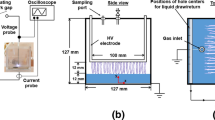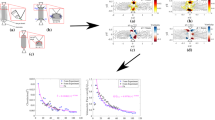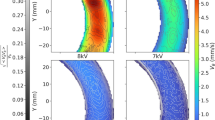Abstract
In this work, particle image velocimetry has been used to visualize and quantify plasma-induced flow fields in liquid water. Experiments were performed in a rod-plane plasma reactor with a thin wire electrode suspended above the surface of the liquid in argon gas and a grounded plate immersed in the liquid. The velocity field has been quantified for two types of solutions: (1) aqueous NaCl solutions of varying solution conductivities and discharge frequencies and (2) aqueous NaCl solutions containing varying concentrations of the following four organic compounds: rhodamine B dye, caffeine, fluoxetine, and perfluorooctanoic acid. Results show that in neat water and aqueous caffeine solutions, the liquid is “pulled” along by the interaction of the gas molecules with the liquid molecules at the free surface and thus the direction of the liquid flow is in the direction of the gas phase flow (i.e., away from the discharge location). However, the flow was reversed (i.e., towards the discharge) for those solutions with strong surfactants such as perfluorooctanoic acid. The magnitude of the reversal depended on the initial concentration of the compound and for some compounds as time progressed the reversed flow pattern weakened and then reverted to a normal flow pattern. To determine the most likely cause of these flow reversals, a simple numerical model of the velocity field was developed to estimate relative contributions of various flow inducing mechanisms. The model indicates that in the presence of surfactants, Marangoni stresses are responsible for inducing the flow in the liquid.

















Similar content being viewed by others
References
Fridman A, Kennedy LA (2004) Plasma physics and engineering. CRC Press, Boca Raton
Foster JE (2017) Plasma-based water purification: challenges and prospects for the future. Phys Plasmas 24:055501
Shimizu T, Iwafuchi Y, Morfill GE, Sato T (2011) Formation of thermal flow fields and chemical transport in air and water by atmospheric plasma. New J Phys 13:053025
Kawasaki T, Eto W, Hamada M, Wakabayashi Y, Abe Y, Kihara K (2015) Detection of reactive oxygen species supplied into the water bottom by atmospheric non-thermal plasma jet using iodine-starch reaction. Jpn J Appl Phys 54:086201
Go DB, Maturana RA, Fisher TS, Garimella SV (2008) Enhancement of external forced convection by ionic wind. Int J Heat Mass Transf 51:6047–6053
Moreau E, Touchard G (2008) Enhancing the mechanical efficiency of electric wind in corona discharges. J Electrostat 66:39–44
Robinson M (1962) A history of the electric wind. Am J Phys 30:366–372
Zhao L, Adamiak K (2016) EHD flow produced by electric corona discharge in gases: from fundamental studies to applications (a review). Part Sci Technol 34:63–71
Cagnoni D, Agostini F, Christen T, Parolini N, Stevanović I, De Falco C (2013) Multiphysics simulation of corona discharge induced ionic wind. J Appl Phys 114:233301
Vatazhin A, Likhter V, Ulybyshev K (2012) “Ion wind”, a gas-dynamic flow in the corona discharge, and its interaction with the external flow. Fluid Dyn 47:206–213
Zhao L, Adamiak K (2005) EHD flow in air produced by electric corona discharge in pin–plate configuration. J Electrostat 63:337–350
Lindsay A, Anderson C, Slikboer E, Shannon S, Graves D (2015) Momentum, heat, and neutral mass transport in convective atmospheric pressure plasma-liquid systems and implications for aqueous targets. J Phys D Appl Phys 48:424007
Kawamoto H, Umezu S (2005) Electrohydrodynamic deformation of water surface in a metal pin to water plate corona discharge system. J Phys D Appl Phys 38:887–894
Ohyama R-I, Kaneko K, Chang J-S (2003) Flow visualization and image analysis of gas-phase AC corona discharge induced electrohydrodynamic liquid flow in a stratified fluid. IEEE Trans Dielectr Electr Insul 10:57–64
Dai F, Fan X, Stratton GR, Bellona CL, Holsen TM, Crimmins BS, Xia X, Mededovic Thagard S (2016) Experimental and density functional theoretical study of the effects of Fenton’s reaction on the degradation of Bisphenol A in a high voltage plasma reactor. J Hazard Mater 308:419–429
Adrian RJ (2005) Twenty years of particle image velocimetry. Exp Fluids 39:159–169
Michard M, Graftieaux L, Lollini L, Grosjean N (1997) Identification of vortical structures by a non local criterion—application to PIV measurements and DNS-LES results of turbulent rotating flows. In: 11th Symposium on turbulent shear flows, Grenoble
Mededovic Thagard S, Stratton GR, Dai F, Bellona CL, Holsen TM, Bohl D, Paek E, Dickenson ERV (2017) Plasma-based water treatment: development of a general mechanistic model to estimate the treatability of different types of contaminants. J Phys D Appl Phys 50:014003
Palit SR (1956) Thermodynamic interpretation of the eotvos constant. Nature 177:1180
Hirata A, Kawakami M, Okano Y (1989) Effect of interfacial velocity and interfacial tension gradient on momentum, heat and mass transfer. Can J Chem Eng 67:777–786
Acknowledgements
The authors thank the National Science Foundation (Division of Physics, NSF/DOE Partnership in Basic Science and Engineering, Award Number 1617822) for funding this work.
Author information
Authors and Affiliations
Corresponding author
Rights and permissions
About this article
Cite this article
Thagard, S.M., Stratton, G.R., Vasilev, M. et al. An Experimental Investigation of the Liquid Flow Induced by a Pulsed Electrical Discharge Plasma. Plasma Chem Plasma Process 38, 719–741 (2018). https://doi.org/10.1007/s11090-018-9905-3
Received:
Accepted:
Published:
Issue Date:
DOI: https://doi.org/10.1007/s11090-018-9905-3




